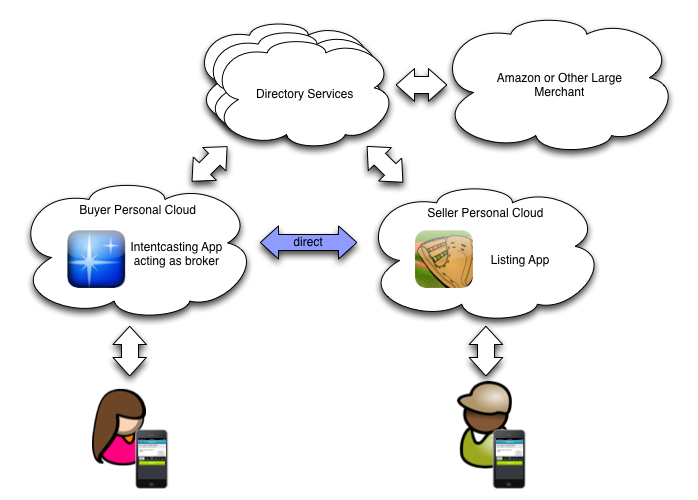Summary
This blog post lays out the roles of the various parties in an intentcasting scenario. We argue for directories that allow discovery of products by buyers and act on behalf of sellers. In addition, we envision brokers working for the buyer in their personal cloud.

In the motorcycle intentcasting scenario I wrote about in June, I discussed the need for a brokerage service, that I called FastStuff:
FastStuff is a brokerage service that supports intentcasting around high value items like motorcycles. The broker supports publishing intents and subscribing to filtered intent streams. The broker also provides discovery and reputation services.From Buying a Motorcycle | Phil Windley's Technometria
Referenced Wed Sep 05 2012 12:53:17 GMT+0200 (CEST)
As we've built out more of the scenario, my thinking on this has evolved a little. I still believe there will be a brokerage function, but we need to break the directory function out of the brokerage so that it's independent. The brokers work on behalf of the buyer and directories work on behalf of the seller. In my current thinking FastStuff is a directory and the broker operates as an app in the buyer's personal cloud. Here's some details:
Directory Services
The directory provides information about what's for sale. The directory allows buyers to discovery products from sellers. This is a natural extension of what places like eBay and Craiglist do for small merchants and one-time sellers. You could also imagine large retailers like Amazon building a directory service for themselves and their merchants. Ecommerce software vendors could easily add directory services to their platforms.
Directories will compete for business on the basis of their ability to make the products listed there discoverable to the widest range of buyers. They are the Yellow Pages of the future.
Brokerage Services
The broker receives intentcasts from the buyer and matches them with items for sale. The broker works on behalf of the buyer and consequently has a vested interest in protecting the buyers privacy and getting the best deal for the buyer. The broker is not a website running somewhere else, it's an app running in the buyer's personal cloud. The apps knows about various directories and is tied into various trust frameworks, through services in the personal cloud.
The broker might make use of various APIs, including the directory APIs for whatever directories it works with. Brokers distinguish themselves by what directories they can access, the algorithms they use to match the intent to buy with items for sale, and their reputation for providing good results and protecting buyer privacy.
Interactions Between Sellers and Buyers
As shown in the following diagram, buyers and sellers each have a personal cloud that gives them a personal, permanent online presence. They have applications that run in those personal clouds that they interact with via devices like their smartphones or laptops.

Note that the smarts are in the apps in the cloud, not on their device. This is a principle of power. Giving individuals cloud-based personal computing platforms that they control, we increase their independence. In addition, by putting the smarts in the cloud, users gain the advantage of being always online and reachable. Most user devices are NAT'd or behind firewalls and that reduces their utility in creating decentralized relationship networks. Thus most user devices will be relegated to accessing the places where the real data is stored and the real computation is done.
The buyer is running an intentcasting application in their personal cloud that functions as the broker. She thinks of this as a smart shopping assistant—a personal shopper. By virtue of running in her personal cloud, the intentcasting app has permissioned access to information about the buyer from her personal data store. The buyer interacts with the intentcasting app to fashion specifications of what she wants to buy. For most items, this process need not be any more complicated than adding something to a wishlist or clicking on a Want button. The app uses that signal, in conjunction with information it already knows about the buyer to fashion the intent specification.
Meanwhile sellers (individuals or merchants) have listed their products. As we said, for large merchants, the directory may be an API on their own web site. Smaller merchants and individual sellers would use directories provided by places like eBay, classified ad sites, or other online product directories. Large merchants have this functionality built into their systems. Smaller merchants and individuals would use apps in their personal cloud to create the listing or do it manually via a web interface like they do today.
The broker matches intent specifications with products in directories to find likely matches. When matches are found, the buyer reviews them. Rating systems built into the app (e.g. "show me more like this") allow the broker to get smarter about the buyer's preferences about the user's perferences in general as well as about particular intent specifications. When the buyer finds a product she likes from a seller she trusts, she is able to request more information and move forward with the transaction through a direct connection between the buyer and seller's respective online services. For most buyers and individual sellers this would be a personal cloud. For large merchant it would be their normal online storefront.




